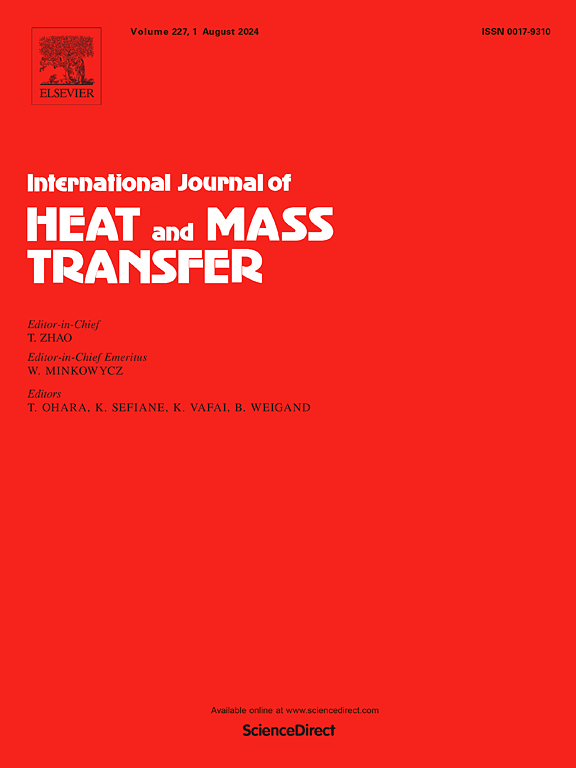IF 5
2区 工程技术
Q1 ENGINEERING, MECHANICAL
International Journal of Heat and Mass Transfer
Pub Date : 2025-02-20
DOI:10.1016/j.ijheatmasstransfer.2025.126829
引用次数: 0
摘要
精确监测和预测沸腾动态对于确保热力系统临界状态下的可靠性至关重要。本研究采用卷积神经网络 (CNN) 算法进行图像分类,以识别不同工作条件下的沸腾现象,包括单相流、核沸腾和临界前热流状态。用于训练模型的数据集来自焦耳效应加热的流动沸腾实验装置,与池沸腾相比,这种配置在这方面的探索较少。此外,研究还对工作流体(水、乙二醇-水混合物和氢氟醚)和加热板(无纹理或微纹理表面)进行了分类。使用混淆矩阵和性能指标(包括精确度、召回率、F1 分数和马修斯相关系数 (MCC))对四种 CNN 架构(AlexNet、ResNet、InceptionNet 和标准 CNN)进行了评估。此外,还将其性能与之前的一种方法进行了比较,该方法涉及下采样、主成分分析和支持向量机。之前报告的方法在沸腾状态分类和流体分类中分别达到了约 58% 和 61% 的 MCC 值。相比之下,先进的 CNN 模型则表现出明显的优越性能。AlexNet 在沸腾状态分类方面的 MCC 值分别为 97 % 和 96 %,在流体类型分类方面表现出色,训练和测试的 MCC 值分别为 98 % 和 99 %。在板材类型分类方面,InceptionNet 的 F1 分数约为 98%。这些发现凸显了 CNN 算法在准确分类沸腾现象方面的有效性,为通过直接可视化分析和监控流动沸腾系统提供了强大的工具。本文章由计算机程序翻译,如有差异,请以英文原文为准。

Classification of boiling regimes, fluids, and heating surfaces through deep learning algorithms and image analysis
Precise monitoring and forecasting of boiling dynamics are crucial for ensuring reliability near critical conditions in thermal systems. This study applies Convolutional Neural Network (CNN) algorithms for image classification to identify boiling phenomena under different operating conditions, including single-phase flow, nucleate boiling, and pre-critical heat flux states. The dataset used to train the models was obtained from a Flow-Boiling experimental setup with Joule effect heating, a configuration less explored in this regard compared to pool boiling. Additionally, the study also classifies the working fluid (water, ethylene glycol-water mixture, and hydrofluoroether) and the heating plate (non-textured or micro-textured surfaces). Four CNN architectures (AlexNet, ResNet, InceptionNet, and a standard CNN) were evaluated using confusion matrices and performance metrics including precision, recall, F1-score, and Matthews Correlation Coefficient (MCC). The performance was also compared to a previous methodology involving downsampling, Principal Component Analysis, and a Support Vector Machine. This previously reported method achieved MCC values of around 58 % for boiling regime classification and 61 % for fluid classification. In contrast, advanced CNN models demonstrated significantly superior performance. AlexNet achieved MCC values of 97 % and 96 % for boiling regime classification and excelled in fluid type classification, with MCC values of 98 % and 99 % for training and testing, respectively. For plate type classification, InceptionNet achieved an F1-score of approximately 98 %. These findings highlight the effectiveness of CNN algorithms in accurately classifying boiling phenomena, offering robust tools for analyzing and monitoring flow boiling systems through direct visualization.
求助全文
通过发布文献求助,成功后即可免费获取论文全文。
去求助
来源期刊
CiteScore
10.30
自引率
13.50%
发文量
1319
审稿时长
41 days
期刊介绍:
International Journal of Heat and Mass Transfer is the vehicle for the exchange of basic ideas in heat and mass transfer between research workers and engineers throughout the world. It focuses on both analytical and experimental research, with an emphasis on contributions which increase the basic understanding of transfer processes and their application to engineering problems.
Topics include:
-New methods of measuring and/or correlating transport-property data
-Energy engineering
-Environmental applications of heat and/or mass transfer

 求助内容:
求助内容: 应助结果提醒方式:
应助结果提醒方式:


